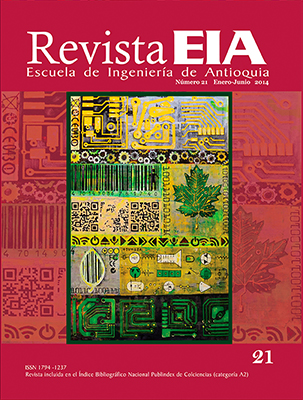DETECCIÓN DEL DISCO ÓPTICO EN RETINOGRAFÍAS MEDIANTE UNA ESTRATEGIA EVOLUTIVA (μ+λ)
DETECCIÓN DEL DISCO ÓPTICO EN RETINOGRAFÍAS MEDIANTE UNA ESTRATEGIA EVOLUTIVA (μ+λ)


This work is licensed under a Creative Commons Attribution-NonCommercial-NoDerivatives 4.0 International License.
Copyright statement
The authors exclusively assign to the Universidad EIA, with the power to assign to third parties, all the exploitation rights that derive from the works that are accepted for publication in the Revista EIA, as well as in any product derived from it and, in in particular, those of reproduction, distribution, public communication (including interactive making available) and transformation (including adaptation, modification and, where appropriate, translation), for all types of exploitation (by way of example and not limitation : in paper, electronic, online, computer or audiovisual format, as well as in any other format, even for promotional or advertising purposes and / or for the production of derivative products), for a worldwide territorial scope and for the entire duration of the rights provided for in the current published text of the Intellectual Property Law. This assignment will be made by the authors without the right to any type of remuneration or compensation.
Consequently, the author may not publish or disseminate the works that are selected for publication in the Revista EIA, neither totally nor partially, nor authorize their publication to third parties, without the prior express authorization, requested and granted in writing, from the Univeridad EIA.
Show authors biography
En este artículo se presenta un procedimiento para la detección del disco óptico (DO) en retinografías, mediante un algoritmo evolutivo. El procedimiento tiene dos etapas principales: la detección gruesa de la posición del DO y el refinamiento de los bordes del contorno. La detección gruesa ubica la posición del DO mediante un algoritmo evolutivo, cuyos individuos tienen como función objetivo la cantidad de píxeles brillantes y el número de bordes de la red de conductos sanguíneos, contenidos dentro de una circunferencia. La etapa de refinamiento aplica un procedimiento geométrico, para deformar el círculo inicial, ajustando el borde de éste con la posición del píxel de mayor variación en dirección al vector normal. El procedimiento fue evaluado empleando los repositorios públicos STARE y DIAREDB, procesando imágenes de pacientes sanos y con alteraciones de las retina, generadas por la presencia de retinopatía diabética. Los resultados experimentales muestran que el método propuesto puede identificar la posición del disco óptico en retinografías con una precisión cercana al 96 %.
Abstract: In this paper we show an optic disk (OD) detection approach based on evolution strategy (ES). The approach has two main steps: Coarse detection and contour edges refinement. Coarse detection estimates an approximated position using a ES in which each individual has a fitness function based on the bright pixels amount and the vasculature structure edge pixels quantity inside a circle. The contour edge refinement uses a geometrical approach to circle deformation in order to adjust the edge circle with OD edges. For this, the pixel with the largest intensity value variation along a normal line is considered. The proposed approach was evaluated using the STARED and DIAREDB public repository, processing normal and disease patient states retinal images. The results show that the proposed method identifies the optic disk position with an accuracy of 96 %.
Article visits 223 | PDF visits 202
